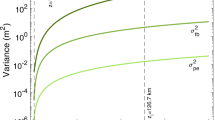Abstract
Quantum satellite communication has advantages of reliability and unconditional safety; it is very important in the field of national military security. When quantum signals are transmitted over a free-space channel, various environmental factors will unavoidably influence quantum communication performance, such as clouds, aerosol particles, and rainfall. However, up to now, research on the impact of bioaerosols on the performance of quantum satellite communication in free space has not been carried out. Therefore, in this work, we experimentally simulate the fractal structure of microbial agglomerated particles by a cluster–cluster model. Since microbial agglomerated particles are suspending in the air, they have an energy-absorbing effect on quantum light signals, which is called the extinction effect. We calculate the extinction efficiency factors by discrete dipole approximation. Based on the particle-size distribution function and the extinction coefficient of microbial agglomerated particles, we respectively establish relationships between the particle concentration, quantum link attenuation, channel capacity, and channel survival functions, as well as bit error rates for the bit-flip channel and the depolarized channel. Our simulation results show that different concentrations of microbial agglomerated particles have different effects on the performance of quantum communication, which provide a reference for the adjustment of quantum communication parameters in microbial environment.
Similar content being viewed by others
References
P. Villoresi, T. Jennewein, F. Tamburini, et. al., New J. Phys., 10, 033038 (2008).
J. Yin, J. G. Ren, H. Lu, et. al., Nature, 7410, 488 (2012).
J. Yin, Y. Cao, H. L. Yong, et. al., Phys. Rev. Lett., 110, 260407 (2013).
A. Muller, J. Breguet, and N. Gisin, Europhys. Lett., 23, 383 (1993).
J. Yin, Y. H. Li, S. K. Liao, et. al., Nature, 7813, 501 (2020).
M. Nie, J. M. Ren, G. Yang, et. al., Acta Photon. Sin., 45, 0927004 (2016) [in Chinese].
J. Ren, M. Nie, G. Yang, and C. X. Pei, Acta Photon. Sin., 44, 146 (2015) [in Chinese].
X. Z. Zhang, X. Xu, and B. Y. Liu, Acta Opt. Sin., 40, 165 (2020) [in Chinese].
M. C. Feng, L. Xu, M. G. Gao, et. al., Spectroscopy and Spectral Analysis, 32, 3193 (2012) [in Chinese].
X. Y. Zhao, Y. H. Hu, Y. L. Gu, and L. Li, Acta Opt. Sin., 35, 222 (2015) [in Chinese].
H. Zhao and X. Y. Zhao, Acta Opt. Sin., 16, 112 (2018) [in Chinese].
X. Chen, Y. H. Hu, Y. L. Gu, et. al., Infrared Laser Eng., 48, 34 (2019) [in Chinese].
C. Li and H. Xiong, Comput. Phys. Commun., 185, 3424 (2014) [in Chinese].
M. Lattuada, H. Lattuada, and M. Morbidelli, Chem. Eng. Sci., 59, 4401 (2004).
T. Kozasa, J. Blum, and T. Mukai, Astron. Astrophys., 263, 423 (1992).
Y. X. Xie, W. F. Luo, and H. Q. Li, World Sci.-Tech. Res. Dev., 26, 24 (2004) [in Chinese].
C. J. Huang, Z. S. Wu, Y. F. Liu, and S. M. Liu, Acta Opt. Sin., 33, 0129001 (2013) [in Chinese].
V. Lucarini, J. J. Saarinen, and K. E. Peiponen, Kramers–Kronig Relations in Optical Meterials Research, Springer, Berlin, Heidelberg (2005), p. 9.
Y. Feng, “The characteristic of fog extinction in express way and impact on traffic safety,” Changán University, Xián (2009), p. 64 [in Chinese].
H. Yin and H. X. Ma, Introduction to Quantum Communication in Military, Military Science Press, Beijing (2006), p. 227 [in Chinese].
M. Nie, J. Ren, G. Yang, et. al., Acta Phys. Sin.–Ch. Ed., 64, 150301 (2015) [in Chinese].
X. Pei, Quantum Communication, Xidian University Press, Xián (2013) p. 118 [in Chinese].
L. Zhang, M. Nie, and X. H. Liu, Acta Phys. Sin.–Ch. Ed., 62, 150301 (2013) [in Chinese].
M. A. Nielsen and I. L. Chuang, Quantum Computing and Quantum Information [translated by D. Z. Zheng and Q. Zhao, Tsinghua University Press, Beijing (2005), p. 57].
C. H. Bennett and G. Brassard, Quantum cryptography: Public key distribution and coin tossing, arXiv:2003.06557 (2020).
Author information
Authors and Affiliations
Corresponding author
Rights and permissions
About this article
Cite this article
Zhang, X., Zhou, L. & Zhai, M. Influence of Microbial Agglomerated Particles on the Performance of Free-Space Quantum Communication. J Russ Laser Res 42, 473–483 (2021). https://doi.org/10.1007/s10946-021-09985-y
Received:
Published:
Issue Date:
DOI: https://doi.org/10.1007/s10946-021-09985-y




